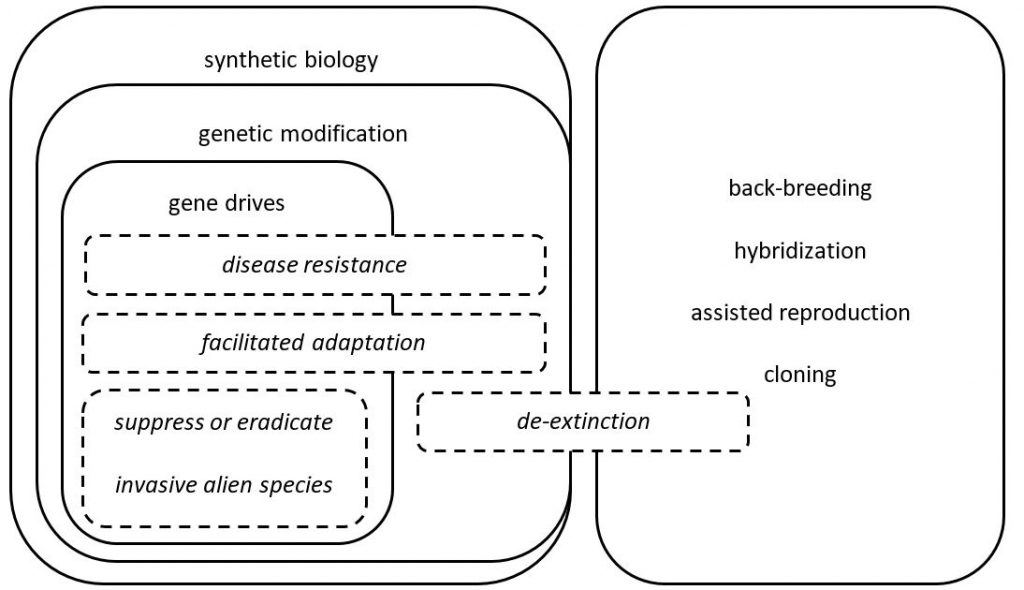In a new paper, I introduce the international governance of synthetic biology, gene drives, and de-extinction for conservation.
Originally published at Legal Planet.
In addition to climate change — the primary topic of my academic writing — biodiversity loss is the other major global environmental challenge. Like climate change, efforts over the last three decades keep failing to meet agreed-upon objectives. And like climate change, scientists and others are considering novel technologies that would intervene in natural systems at large scales in order to meet associated sustainability goals.
I previously introduced technologies to genetically modify wild populations in a series of blog posts (1, 2, 3, 4). In an open access paper just published in Current Opinion in Environmental Sustainability, I offer an overview of these and related technologies, which I call “conservationist synthetic biology.” Some of these technologies could improve ecosystem integrity, function, and resilience; fulfill ethical obligations; satisfy legal duties; and increase public support for conservation. Yet they also pose environmental risks and social challenges.
To organize technologies and applications, I offer the following diagram:

“Synthetic biology” is a poorly defined term, while “genetic modification” is more specific and well-known. A subcategory of the latter would use gene drives, “systems of biased inheritance in which the ability of a genetic element to pass from a parent to its offspring… is enhanced.”
These synthetic biology technologies have four conservationist applications:
- First, genetic modification could confer disease resistance to a threatened species (here including endangered ones). For example, the American chestnut tree could be made resistant to the fungal blight that has nearly caused its extinction.
- Second, in “facilitated adaptation,” genetic modification could increase threatened species’ resilience, such as against anthropogenic climate change. Corals in Australia’s Great Barrier Reef could be modified to withstand warmer and more acidic marine water, both of which are due to elevated atmospheric concentrations of greenhouse gases.
- Third, gene drives could suppress or eradicate populations of invasive alien species, a leading direct drivers of biodiversity loss. This is particularly appealing on islands, which are vulnerable to invasive species and could better contain a gene drive.
- Fourth, biotechnological methods could revive locally, functionally, or globally extinct species, or at least analogs thereof, and reintroduce them in wild settings. This could use “typical” genetic modification as well as selectively breeding similar species through back-breeding and hybridization, assisted reproduction, cloning, and genetic modification. Scientists are researching whether the quagga, heath hen, passenger pigeon, and others could be returned.
The paper discusses the environmental risks and social challenges of conservationist synthetic biology. For example, genetic modification could affect the species in unexpected ways or spread beyond the target population or species, for example via horizontal gene flow or hybridization. And conservationist synthetic biology could undermine efforts to conserve biodiversity through primary, widely preferred means such as habitat protection, perhaps by consuming limited financial and other resources.
I also discuss how existing legal instrument would govern conservationist synthetic biology. These emerging biotechnologies would be regulated by numerous existing provisions concerning, among other things, endangered species, habitat protection, “traditional” genetically modified organisms, veterinary medicine, animal welfare, biosafety, toxins, and intellectual property. Because researchers, materials, knowledge, and impacts will cross jurisdictional borders, governance will need to be – to some degree – international, where the Convention on Biological Diversity is most important.
The paper concludes with some observations on the emerging politics of conservationist synthetic biology. For one thing, although critics often frame emerging technologies as being hyped by firms and boosters, this is not the case with conservationist synthetic biology. For another, emerging technologies are sometimes resisted by environmentalists. But given conservationist synthetic biology’s applications and potential as well as the insufficient progress in conserving biodiversity, opposition may be diffused. Ultimately, conservationist synthetic biology cuts right to the heart of environmentalism’s meaning. In a persistent echo of the movement’s “small is beautiful” legacy, many environmentalists seem quick to embrace technological opportunities when they are decentralized, visible, relatively familiar, and in consumers’ control, such as solar panels, insulation, and electric cars, while resisting technologies that are centralized, invisible, relatively unfamiliar, and in others’ control, such as nuclear power, climate geoengineering, and biotechnology.
